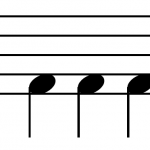One of the best ways to improve your skills as a drummer is to learn drum notation.
You can use it to notate drums’ rhythms, melodies, and chord progressions. Drum notation can help you develop your timing, groove, and overall musicianship.
Although many people consider it a complex skill, drum notation is more straightforward than most musicians think. Besides, if you can count rhythms, you’re already halfway there to reading drum notation like a pro! And the best part is that there are so many ways you could learn the skill.
So, want to know more about drum notation?
Keep reading this detailed guide that includes everything you need to know. We also answer some commonly asked questions, so stick around to the end!
What is Drum Notation?
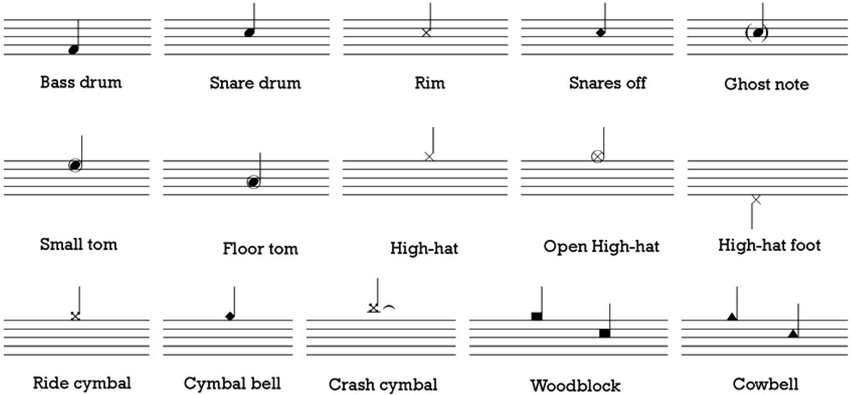
Drum notation is, essentially, a series of symbols above the staves that tells you how to play the drum parts. There are several different forms of music notation for drums. The most popular include:
- Standard Drum Notation
- Sticks and Brushes
However, there are dozens more. If you ever want to write out your drum parts, you must be familiar with this notation. They allow the drummer to keep track of their beats and rhythms, which is especially useful when playing with other musicians.
Standard drum notation: It’s the most well-known and widely used version. This notation uses note heads and stems just like any other musical notation. It’s sometimes known as “dance band” writing because most popular music is composed and notated in this way.
Sticks and Brushes: The “sticks” notation is very similar to standard drum notation, but instead of using the note heads, it uses number values. This form of writing indicates how hard you should hit your instrument or how/where you should hold the sticks. In contrast, the “brushes” notation is similar to standard drum notation. These symbols indicate precisely where you should play on your snare drum and how hard you should hit it.
Drum Notation Guide for Beginners
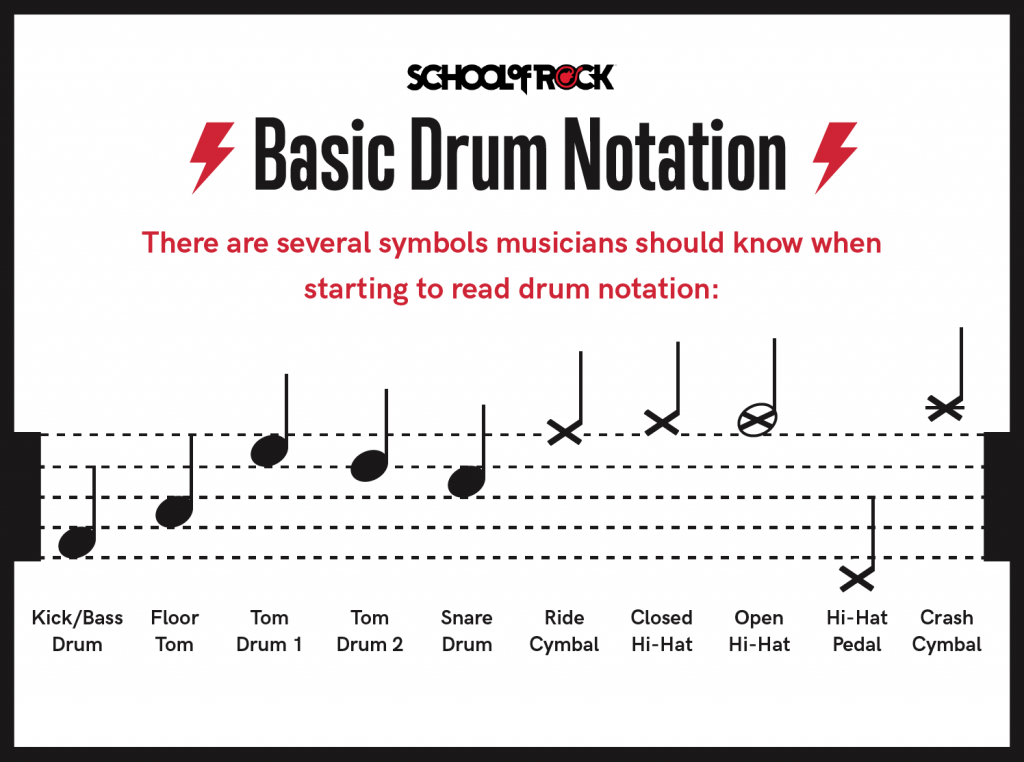
The good news is that learning drum notation isn’t too tricky. In our drum notation guide, we’ll discuss how to read drum parts as well as the symbols themselves. For beginners, you should start with the basics. It means learning how to read standard drum notation and using this format for most of your writing.
- Standard Drum Notation has four lines representing the snare drum, bass drum, hi-hats, and cymbals. The symbols above the staff represent what you should play on your drum set. For example, you can play a quarter note by hitting the bass drum with one foot and the snare drum with the other.
- The half note would be hit twice as hard as a quarter note, and a whole note is struck only lightly. If you want to know how to read drum notation, you will have to learn how to count the beat. For example, in 4/4 time, each quarter note is counted with a “one-two” rhythm. Similar rhythms are used in most other time signatures as well.
- A quarter note gets one beat, a half note receives two beats, and a whole note is counted as the length of four beats. A dotted half note (three beats) gets one-and-a-half beats, while dotted quarter notes (two beats) only receive one beat.
- A tied eighth note also holds for the total value of the beat. If you want to learn how to read drum notation, we recommend beginning with the basics.
Drum Key

The drum key looks like a standard piano key, but it is read from top to bottom. It’s because drummers typically play standing up and cannot look at their hands as they’re playing. Even if you play while seated, this layout will be more comfortable for you.
You’ll notice that each part of the drum key is split up into sections of four and three. The 4-3 pattern repeats repeatedly, but you can find breaks in the grid to indicate rests for your hands. These will help you keep track of the different drum parts and how they fit together.
Measures and Bar Lines
You’ll also notice the presence of vertical bar lines. These show where each measure begins and ends. How many beats are inside a measure can be read from left to right, starting with the top line and going down.
For example, if there were four beats in a measure that began on the second line, you would count down to the second line rather than up from the first. It might be a little confusing at first, so you’ll want to keep practicing until it becomes second nature.
Triplets
Drum notation also specifies rests via empty boxes equal in length to three notes. For example, if you wanted to indicate that your hands should rest for a beat, you would draw an empty box on the third line. If you wanted to stop playing for two beats, you’d put that box on the fourth line.
These rests are called “triplets” because they’re three notes long and come in threes. Drummers typically use them when playing grooves rather than actual songs. Many rock and pop music use triplets in their drum lines, where the term comes from.
Time Signatures
You’ll also notice the presence of time signatures along the bottom. The top number tells you what type of note will receive one beat, while the bottom specifies how many moments are in each measure. So, if there were four beats in every step that started at the second line, you could read this as 4/4. Easy, right?
Dotted Notes and Rests
There are also dotted notes, which are notes with a dot placed after them. The dot’s position tells you whether or not it receives an additional beat. If there is no dot, then the note only has the number of beats specified by its time signature. However, if there is a dot, the note will receive half of a beat.
So, if the note is dotted and there are six beats in a measure that starts at the second line, it would receive 1.5 beats. If there were four triplets in every measure, it would also receive half of a beat.
It’s worth noting that rests can also be dotted if you indicate that they receive half of a beat. It is typically used in drum notation when the drummer plays either very fast or plays between songs, such as during an interlude. Many funk and jazz music also uses this type of dotted rest as part of their overall sound.
How to Read Drum Notation?
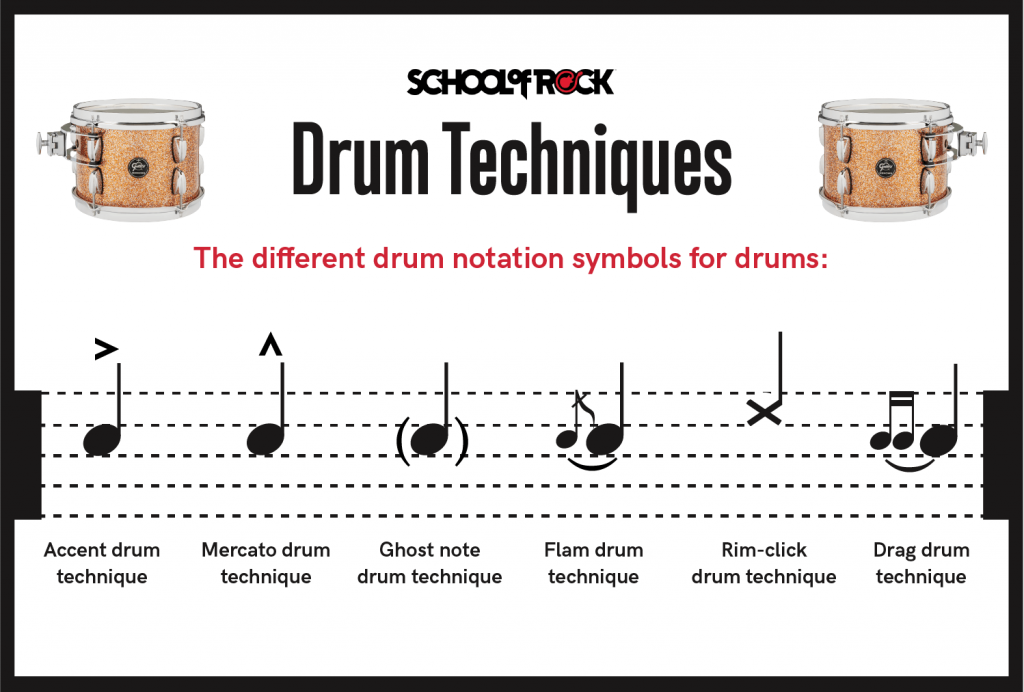
Drum notation is very similar to drum sheet music. The basic idea is that the drummer writes down their notes–beats or rhythms, which will help them keep time with other players in a band setting. They are intended to be played by one person at a time, unlike full sheet music, where anyone can use it on any instrument of their choice.
Generally, reading drum sheet music symbols is pretty straightforward. However, drummers will usually add a unique flair to drum notation sheets to make them more accessible for them to read and understand. These drum notation symbols can take some time getting used to, though, especially if you’ve never seen them before (or maybe even if you have!) A drum set notation sheet usually comprises the following drum notation symbols.
The drum set notation sheet is generally broken down into two different parts: beats and rhythms. Beats are the drumming sounds you hear in drum music, whereas rhythms are defined as the carriage of rhythm through time, which will likely consist of drum beats (or drum sounds.)
Also, the snare drum notation is a drum line that is a lot easier to read and understand because it includes a symbol for the snare drum.
The drum beats are very similar to sheet music, with the notes written on the staves. The drum rhythm symbols are placed above or below each note. Drumbeats will often be centered around a bass drum notated using small drum notation symbols.
Rhythm symbols are semicircles, slashes, lines, and dots. There are specific note values for each type of drum beat notation symbol. Semicircle shapes represent that rest is being played or silence in the music. They will use a line with an arrow at one end to connect any number of drum symbols and become a group of note values.
A line with no arrow is used to separate different beats of notes. Furthermore, you can find a dot following any other symbol above or below the line representing a drumming sound (i.e.: tom-tom drums)
Most Frequently Asked Questions
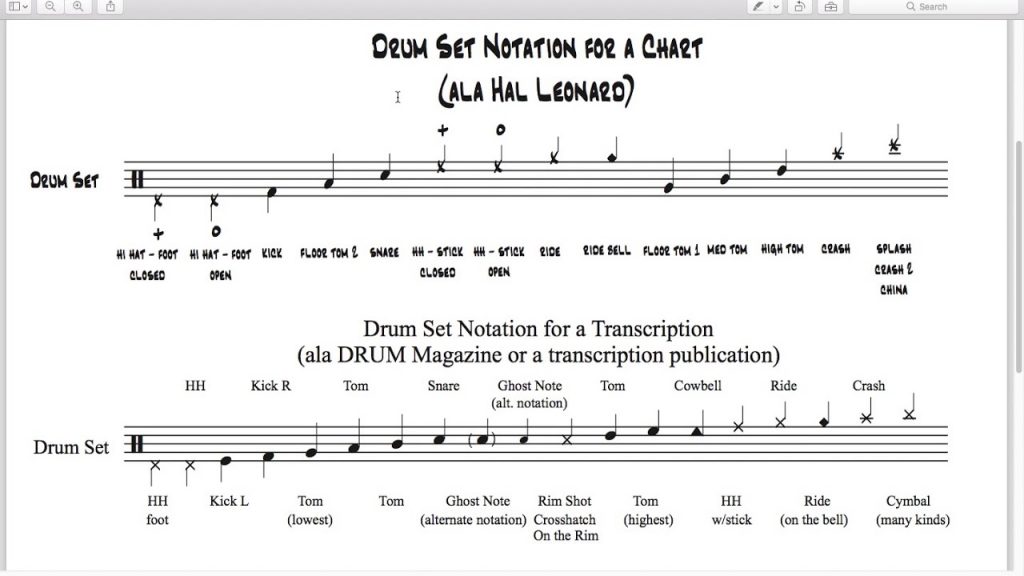
What Are The Drum Symbols Called?
The drum symbols representing the different strokes and accents are called “noteheads”. These symbols are used for other percussion instruments, such as xylophones or marimbas. The note head is typically placed on a five-line staff.
The symbols are crucial when reading drum notation since they indicate when, how often, and with what intensity the drum strokes should be played. Moreover, we can consider them as a set of symbols, each signifying the type and intensity of the note.
Is There A Standard Drum Notation?
Yes, there is a standard drum notation. This notation is almost always used when writing out beats for recordings and radio. It also works well if you’re looking to play along with a band – ask the other musicians if they have their special symbols or notations that you might need to know.
Standard drum notation does not always come with a drum set, so you need to purchase it. There are also free notation programs that you can use online. Similar to sheet music, drum notation is read from left to right. If there are multiple sounds played simultaneously, they are written above one another.
Conclusion
To sum up, drum notation is handy and can provide you with many benefits if you’re looking to band together with other musicians in your area. Whether for practice or performance purposes, learning how to read and write notes on a staff sheet will help when practicing the drums.
A drum kit is filled with many different drums, cymbals, and various instruments. Each one has its unique sound, so it can be challenging to convey that same feeling when reading or writing out drum symbols for sheet music.
Knowing about the different drum kit notation symbols will help you understand what other musicians communicate to you via sheet music.




